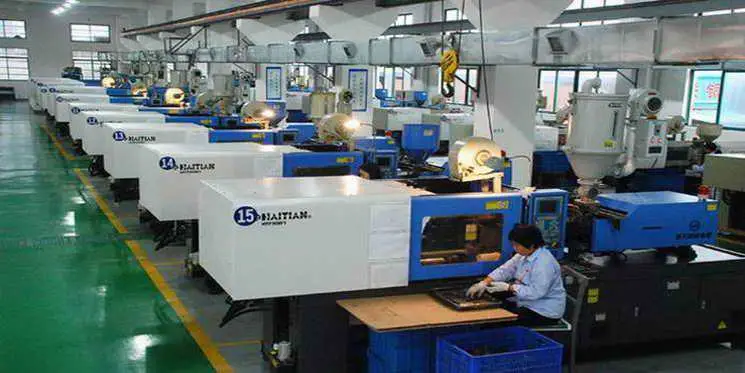What are the causes of plastic products sinking and how do plastic manufacturers solve this problem?
(1) Characteristic of defect
The main manifestation of plastic product sinking is that the surface of the plastic part is not smooth in the plastic manufacturing process, and a shallow pit or pit is formed inward.
(2) Causes of defect and elimination methods
During the cooling process of Plastic Products, the outer layer of the Plastic Product is first cooled and solidified near the cavity, while the inner layer is cooled and solidified later. During the solidification process of the Plastic Product, the internal and external shrinkage is inconsistent, which leads to plastic deformation of the outer layer of the Plastic Product, that is, the outer layer sinks to form a depression. Generally speaking, sinking occurs mainly in the area where the wall thickness of the Plastic Product is the thickest or where the wall thickness changes sharply. The specific analysis is as follows.
1) Injection mold
(1) If the cross-sectional area of the sprue and runner of the mold produced by the injection molding manufacturer is too small, the filling resistance will increase, which is easy to cause sinking. To this end, the cross-sectional area of the corresponding position should be enlarged.
(2) If there is a "bottleneck" in the runner of the injection system, which makes the molten material flow in some parts unsmooth, affecting the pressure transmission, to this end, the runner cross-sectional area should be appropriately enlarged, and there should be no "bottleneck".
(3) If the mold produced by the plastic manufacturer is not sealed well, the pressure in the cavity is uneven and the pressure is low, which leads to sinking. To this end, the sealing performance of the mold should be carefully checked. Many factors affect the sealing performance of the mold, such as mold processing, excessive wear, poor guidance, foreign matter on the parting surface, etc. After finding out the situation, deal with them separately.
(4) If the mold's venting is not good, it will affect the filling of the molten material, leading to shrinkage and sinking. To this end, it is necessary to make sure that the venting system works well, and check it from the design and use.
(5) If the sprue is not symmetrical, the speed of molten material entering each cavity is different, which makes the Plastic Products in each cavity cool unevenly and sink. To this end, the sprue should be placed as symmetrically as possible.
(6) Thick-walled plastic parts are the easiest to sink. To reduce the occurrence of sinking, the selection of the sprue type is more critical. For example, the wing-type sprue has a very good effect in eliminating sinking.
(7) If the mold cooling is not uniform or insufficient, it is very easy to cause sinking. To this end, the design and manufacturing of the cooling system must be taken seriously, and the cooling measures should be strengthened for the parts that are easy to sink.
2) Plastic molding process
(1) If the melt temperature is too high, the plastic part will not cool down enough and is likely to cause the plastic part to sink. In this case, the melt temperature should be lowered.
(2) If the mold temperature is too high, it is easy for the plastic part to sink. In this case, the cooling water volume should be increased or the cooling water temperature should be lowered.
(3) If the injection time and holding time are too short, the melt will not be filled enough and the sinking will occur. In this case, the injection time and holding time should be extended appropriately.
(4) If the injection pressure is too low, the injection speed will be reduced and sinking will occur. In this case, the injection pressure should be increased appropriately.
(5) If the holding pressure is too low, the melt cannot be replenished sufficiently and the sinking will occur. In this case, the holding pressure should be increased appropriately.
(6) For plastic parts with inserts, the thermal expansion coefficient of the insert and the plastic is very different, and the shrinkage rate is also very different, which makes it easy for the insert to produce a depression. In this case, the temperature of the insert can be increased appropriately.
(7) If the depression appears near the gate, the holding time can be extended appropriately; if the depression appears in the wall thickness, the cooling time of the plastic part in the mold can be extended appropriately.
3) Injection molding equipment
(1) If the plastic factory's injection molding machine's feeding system is unstable, which will cause unstable feeding and easy to produce sinking, the feeding system of the injection molding machine should be repaired and the feeding system should be fully supplied.
(2) If the nozzle hole of the injection molding machine is too small or blocked locally, it will cause local loss of injection pressure and easy to produce sinking. In this case, a larger diameter nozzle should be replaced or the nozzle should be cleaned and unblocked.
4) Plastic parts
(1) If the transition at the junction of different wall thicknesses is too fast, it is easy to produce sinking. In this case, the transition at the above-mentioned parts should be smooth.
(2) Plastic parts with inserts are mostly made of metal, and most of them are steel. The thermal expansion coefficient of steel and plastic is too different, which makes it easy for the insert to appear sinking. If we choose a metal with a smaller difference in thermal expansion coefficient and then thicken the plastic layer around the insert, the occurrence of sinking will be greatly reduced.
(3) If the wall thickness of the plastic part is too different, it is very easy to appear sinking. Therefore, when designing the plastic part, the wall thickness should be as equal as possible, or not too different.
5) Raw materials
(1) If the water content or volatile components in the raw material are too high, the excessive gas generated after heating will accumulate in the cavity, making it difficult for the melt to fill the mold smoothly and causing sinking. In this case, the raw material should be dried thoroughly or less raw material with excessive volatile components should be used.
(2) If the amount of lubricant added in the raw material is too small, the fluidity of the melt will be poor and it will be easy to cause sinking. In this case, the amount of lubricant should be increased appropriately.
(3) The greater the shrinkage rate of the resin, the greater the possible sinking, so low-shrinkage resin should be used as raw material as much as possible.






